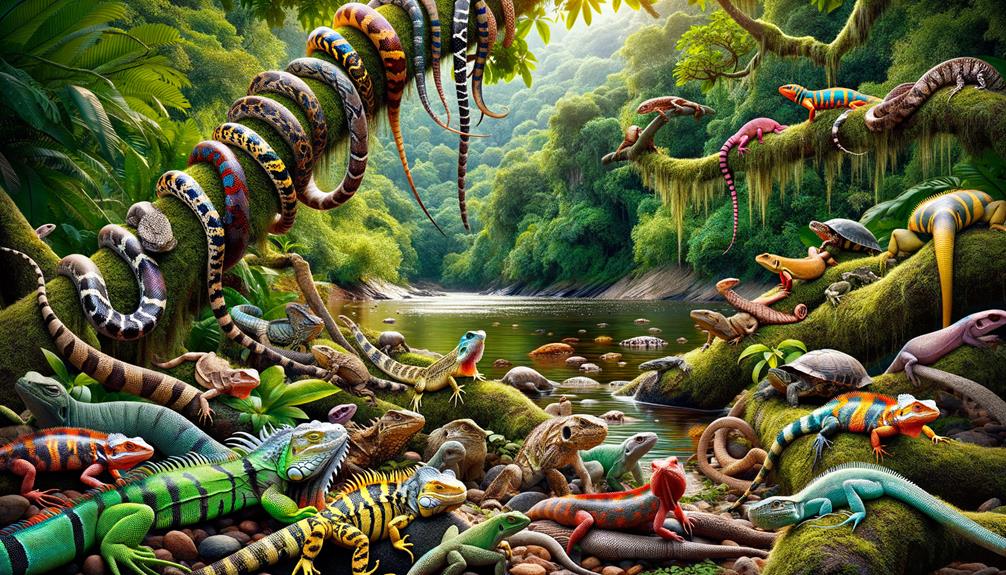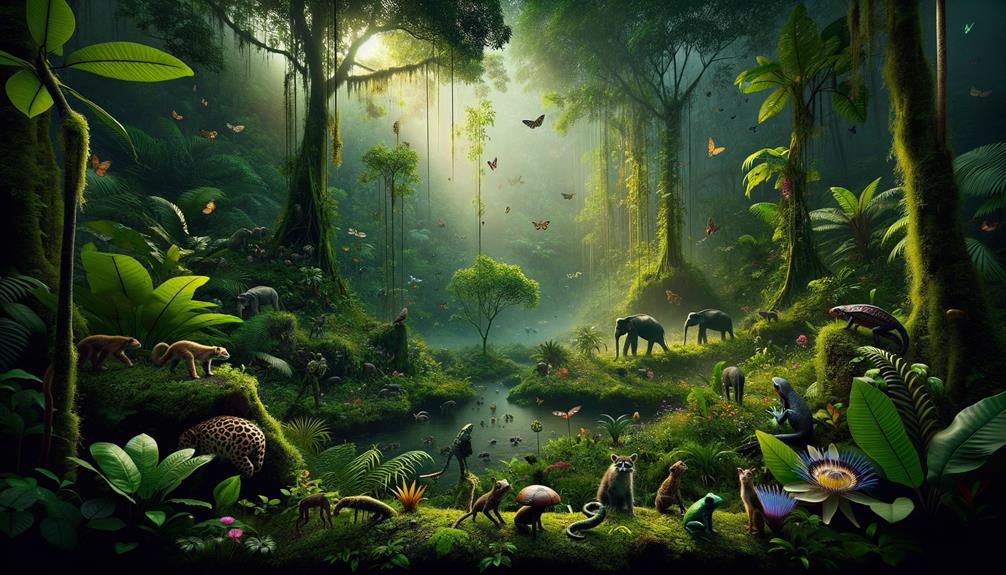I've wandered through Australia's breathtaking tropical rainforests, covering a vast 3.6 million hectares from Queensland to New South Wales. The towering canopy trees create a cool, humid haven, providing a unique environment for rare plant adaptations like strangler figs and epiphytic orchids to thrive. Within these lush sanctuaries, conservation efforts are underway to safeguard this vibrant biodiversity for future generations. Each step in these emerald forest floors uncovers a story of survival and resilience. What secrets will you uncover in these green treasures?
Key Takeaways
Australia's tropical rainforests, spanning over 3.6 million hectares from Queensland to New South Wales, are a treasure trove of biodiversity. The towering canopy trees create a cool, humid microclimate that supports a vast array of species. Unique plant adaptations, such as strangler figs and epiphytic orchids, have evolved remarkable strategies to thrive in these environments. Botanic gardens play a vital role in conserving rare and endangered tropical plant species, supporting their reintroduction and preservation. By doing so, these gardens help safeguard the rich biodiversity of these precious ecosystems.
Lush Rainforests
Australia's tropical rainforests, some of the oldest and most biodiverse on Earth, are a rich tapestry of life that inspires wonder. Spanning from the Wet Tropics in Queensland to the Gondwana Rainforests in New South Wales, these lush ecosystems cover over 3.6 million hectares. As I walk through these verdant domains, I marvel at the towering canopy trees, which reach heights of over 60 meters. They create a cool, humid microclimate, ideal for ferns, palms, and epiphytes to flourish.
These ancient forests provide a sanctuary for numerous endemic and critically endangered species. Among them are the elusive southern cassowary and Lumholtz's tree-kangaroo, both of which rely on the intricate web of life that these rainforests provide. Witnessing such rare creatures in their natural habitat highlights the urgent need for effective conservation efforts.
Thanks to dedicated conservationists, the integrity of these irreplaceable ecosystems is being protected, ensuring their survival for future generations. As I immerse myself in the beauty and complexity of these rainforests, I feel a deep connection to nature and a renewed commitment to preserving its wonders.
Unique Plant Adaptations
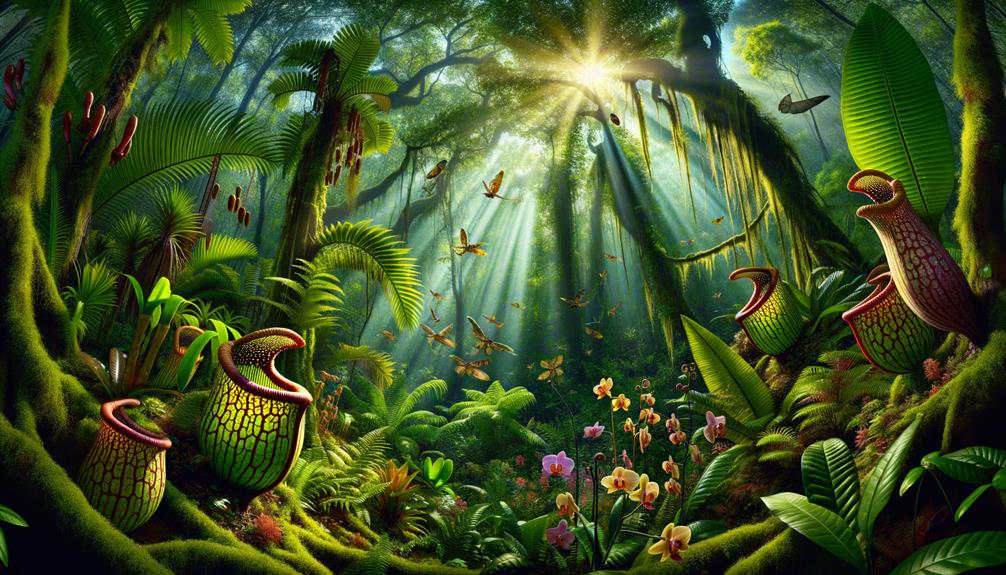
Walking through these ancient rainforests, I'm struck by the incredible adaptations that have evolved to help plants thrive in such a dynamic environment. Every step reveals a new marvel, from towering trees to delicate ferns, each with its own survival strategy.
Take the strangler fig, for example. This plant starts life as a tiny seed high in the canopy, deposited by a bird. From there, it sends roots downward, eventually wrapping around its host tree and taking over. This is a prime example of nature's resourcefulness.
Another fascinating adaptation can be seen in the stilt roots of mangroves. These roots allow the plants to survive in waterlogged, saline soils, elevating them above the challenging conditions below. Then there are the epiphytic orchids, which grow on other plants without harming them, capturing moisture and nutrients from the air.
In the low light of the forest floor, some plants have developed large, broad leaves to capture every bit of sunlight. Others, like many ferns, have evolved to thrive in the shadows with minimal light.
These adaptations demonstrate the resilience and creativity of nature, showcasing how life finds a way in even the most challenging environments.
- Strangler figs: Seed dispersal and root system
- Mangroves: Stilt roots
- Epiphytic orchids: Airborne nutrient capture
- Forest floor plants: Broad leaves for light absorption
Botanic Gardens' Role
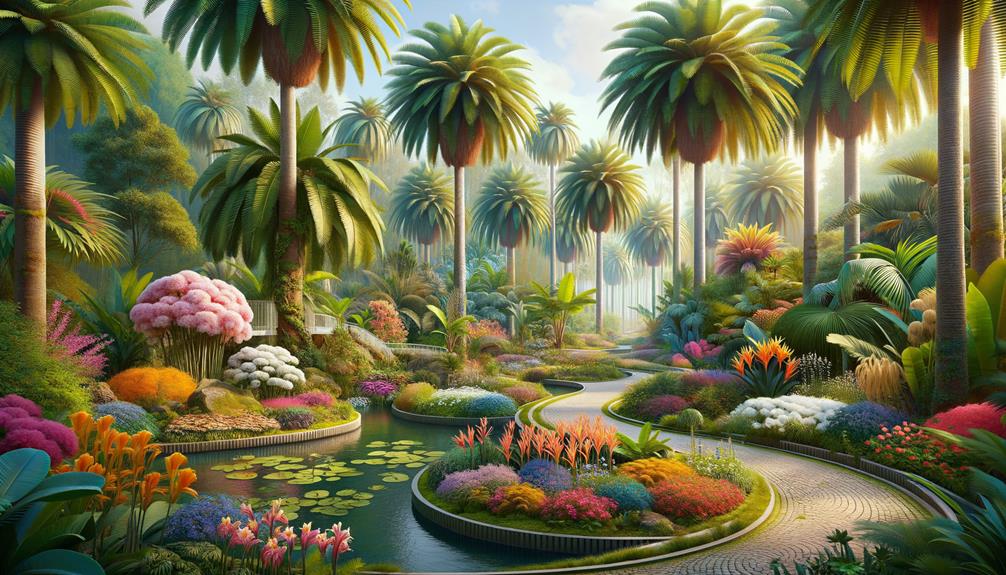
I'm continually fascinated by the vital role botanic gardens play in educating people and preserving our planet's rich plant diversity. These havens aren't just beautiful places to visit; they're living classrooms, where every plant, from towering palms to delicate orchids, tells a story that inspires us to appreciate and cherish the rich tapestry of life around us.
Beyond education, botanic gardens are crucial for conserving plant species. Through meticulous collection and research, they safeguard rare plants that might otherwise disappear. Behind-the-scenes tours reveal the intricate efforts involved in these conservation endeavors, offering a glimpse into the dedication and passion driving these initiatives.
Botanic gardens also advance our understanding through research, studying plant adaptations and evolution to uncover the secrets of tropical biodiversity. This research has real-world implications for conservation strategies and ecological resilience.
These gardens serve as essential repositories of botanical knowledge. Each specimen preserved contributes to a broader understanding of plant life, ensuring that future generations can continue to explore and cherish this incredible diversity. Botanic gardens truly are guardians of our green world, bridging the gap between nature and humanity.
Rare and Endangered Species
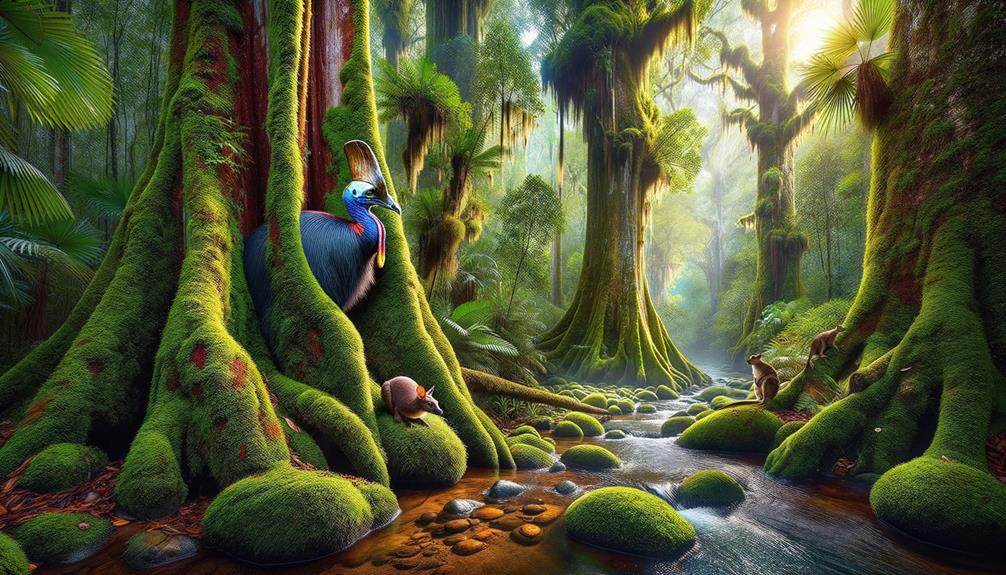
Exploring the world of rare and endangered species, I'm struck by the incredible adaptations these plants have developed to survive in their unique environments. The Euphorbia rosianna, for instance, sheds its leaves in winter, a strategy that helps it cope with the changing seasons of northern India. This resilience is a hallmark of nature's ingenuity.
The critically endangered Brittlemia from Hawaii has an extraordinary ability to store water, allowing it to tolerate periods of neglect. This survival tactic is crucial in its native, often unpredictable habitat.
In Far North Queensland, the Murmur cotija, also known as the ant plant, has evolved a symbiotic relationship with ants. It forms intricate hollows and chambers to house these tiny creatures, providing them shelter in exchange for protection and nutrients.
Lastly, the unidentified Pothos species exhibits a remarkable clinging ability, tightly wrapping around its support to guarantee stability and access to sunlight.
These adaptations are not just survival mechanisms; they embody the spirit of freedom and resilience.
- Euphorbia rosianna: Deciduous, sheds leaves in winter.
- Brittlemia: Critically endangered, stores water.
- Murmur cotija (ant plant): Forms chambers for ants.
- Unidentified Pothos species: Clings tightly to support.
These unique traits are testaments to the resourcefulness of nature, allowing these rare and endangered species to thrive in their environments.
Conservation Efforts

Australia's botanic gardens are pioneers in preserving tropical plant diversity, dedicating meticulous efforts to save rare and endangered species from extinction. Among their prized collections is the critically endangered Brittlemia from Hawaii. These gardens aren't just sanctuaries; they're active hubs where dedicated conservationists work tirelessly to propagate and reintroduce these rare species back into the wild.
As I stroll through these lush gardens, I observe scientists meticulously studying the unique adaptations of tropical plants. Their research is vital, informing strategies that ensure these plants not only survive but thrive when reintroduced into their natural habitats. It's fascinating to witness the synergy of science and nature working in harmony.
Public engagement is also a vital component of these conservation efforts. Through educational programs, the gardens raise awareness about the significance of preserving Australia's diverse tropical flora. Visitors leave not just with memories of vibrant blooms but with a deeper understanding and commitment to safeguarding these natural treasures.
The work being done here is truly remarkable. It's a poignant reminder that preserving our planet's biodiversity is within our grasp, one plant at a time.
Frequently Asked Questions
What Is the Epiphyllum Oxypetalum in Australia?
The Epiphyllum oxypetalum is a popular ornamental cactus in Australia, recognized for its large, fragrant white flowers that bloom at night. It flourishes in bright, indirect light and high humidity, making it a great addition to any indoor space.
What Plants Are in the Tropical Zone in Australia?
In Australia's tropical zone, you'll stumble upon an array of fascinating plants, including philodendrons, anthuriums, and some rare species like the Euphorbia rosianna, Brittlemia, and Murmur cotija. These remarkable plants have adapted to thrive in the region's diverse environments, which range from lush to arid landscapes.


